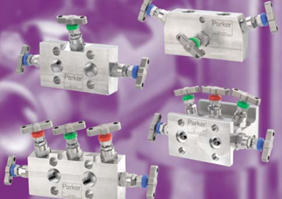

If you’ve ever wondered what a valve manifold is and how they work, then Fluid Controls can give you some pointers in our latest blog. Here, we’ll talk you through the design and functions of regular valve manifolds, as well as explaining their advantages and some of the key features of our range of manifold products from Parker.
Firstly, we must gather a basic understanding of what a valve manifold is. A manifold is a device that connects one or more block/isolate valves of a hydraulic system. Valves of a hydraulic system can include a ball, needle, bleed and vent valves. In the case of a block and bleed manifold, the purpose is to ensure that the fluids from upstream do not come into contact with the components from downstream. This is achieved through isolating the flow of the fluid in the system.
Your typical Parker valve manifold will consist of the following key design features:
These features of our parker valve manifolds can vary slightly depending on what valve manifold you choose of course.
Valve manifolds can be useful in many situations, from small mobile machines to heavy industrial plants. Centring any fluid power system, valve manifolds improve efficiency, and reduce energy costs. Here are a few more benefits of valve manifolds:
Why not read our latest blog entitled ‘Introducing the Parker Pro-Bloc Manifold’ for more product specific information about our premium Parker valve manifolds.
If you would like help from one of our experts to determine which valve manifold you need, then please call us on +44(0) 1189 70 2060. Alternatively, you can email us at fluid@fluidcontrols.co.uk.